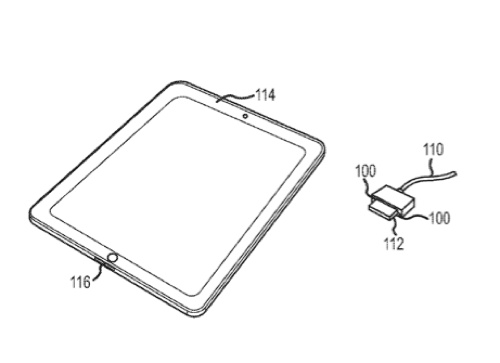A patent (number 20121619) at the U.S. Patent & Trademark Office shows that Apple is working on programmable, magnetic connectors for its iOS devices — and perhaps OS X systems.
Connectors and methods of coupling electronic devices and cables are provided in the patent. In one embodiment, a connector has a first coded magnet on a first surface of a first device. The first coded magnet has at least two different polarity regions on the first surface. A second coded magnet on a second surface of a second device is also provided.
The second coded magnet is configured to provide identifying information regarding the device on which it is located. The inventors are Brett Bilbrey, Aleskander Pance, Peter Arnold, David I. Simon, Jean lee, Michael D. Hillman, Gregory L. Tice, Vijay Iyer and Bradley Spare.
Here’s Apple’s background and summary of the invention: “Electronic devices are common in both home and work environments. Indeed, it is common for multiple electronic devices to be located on a single desk, each with one or more cables interconnecting the devices and/or coupling the devices to power. Generally, the connectors used for such couplings include male and female halves with the electronic devices typically having the female half of the connector. Due to current coupler designs, the female half of the connector and the ports of the electronic devices generally preclude sealing of the housings of electronic devices.
“Turning to the cables, the male half of the connector usually has pins or prongs that insert into the female receiver of the electronic devices when coupled together but are left exposed when not coupled together. Due to this exposure, the pins or prongs may be damaged and render the connector/cable unusable. Additionally, many connectors are device and/or purpose specific. For example, they may have a certain number of pins or prongs that are configured in a particular manner. As such, each device may have multiple unique cables and connectors that are not compatible with other devices.
“Connectors and methods of coupling electronic devices and cables are provided. In one embodiment, a connector has a first coded magnet on a first surface of a first device. The first coded magnet has at least two different polarity regions on the first surface. A second coded magnet on a second surface of a second device is also provided. The second coded magnet is configured to provide identifying information regarding the device on which it is located.
“In another embodiment, a wireless docking system includes a docking station configured to interface with an electronic device and at least one coded magnet on a first surface of the docking station. The first coded magnet has at least two different polarity regions on the first surface. The docking station also includes one or more wireless communication devices positioned on the first surface of the docking station. The docking system additionally includes a docking device having at least one coded magnet located on the docking device in a position that corresponds with the at least one coded magnet of the docking station and at least one wireless communication device configured to communicate with the one or more wireless communication devices.”

